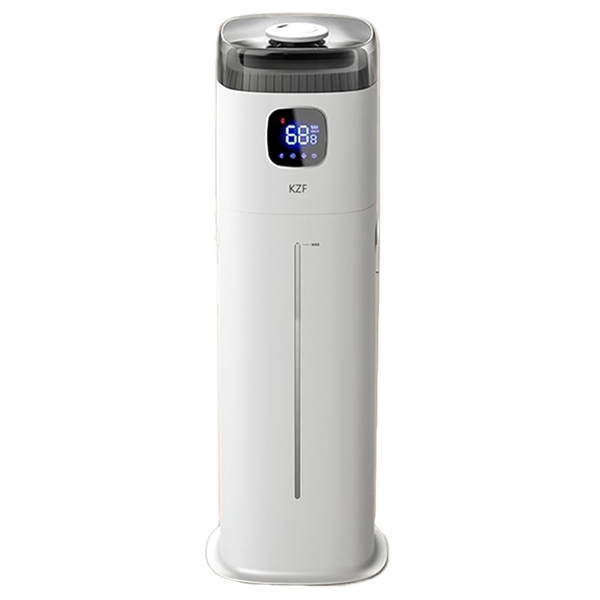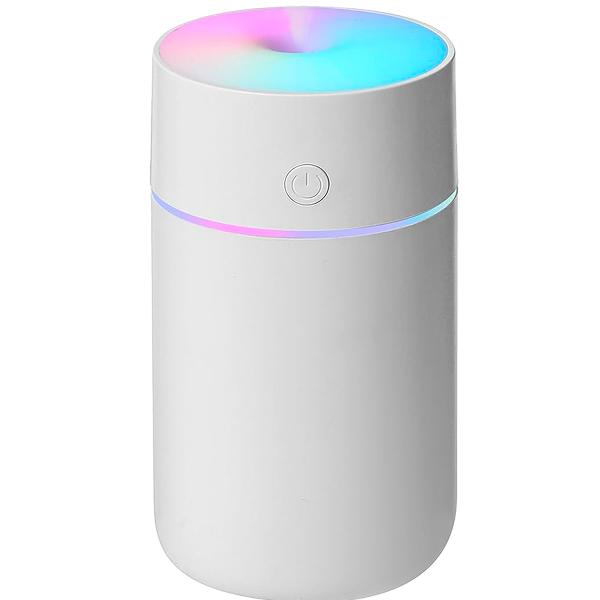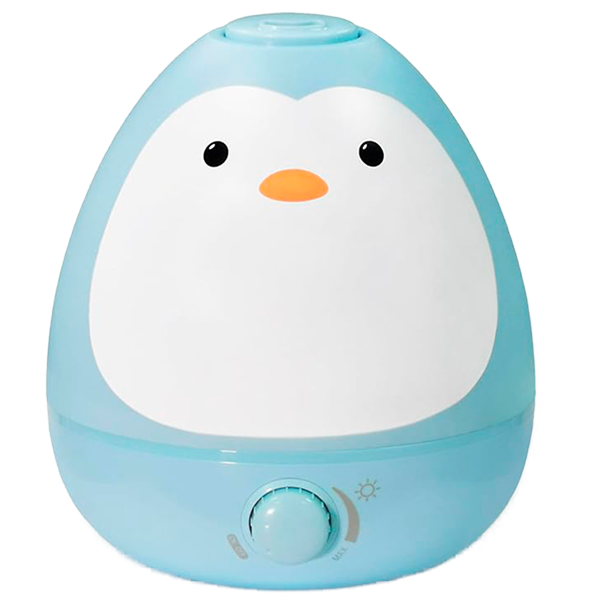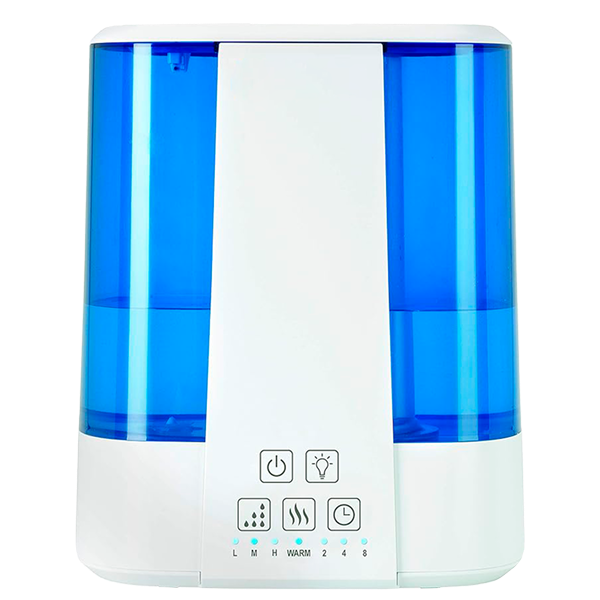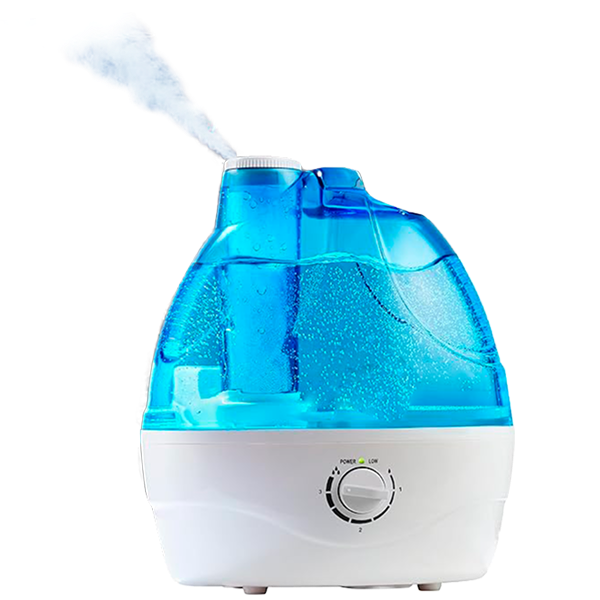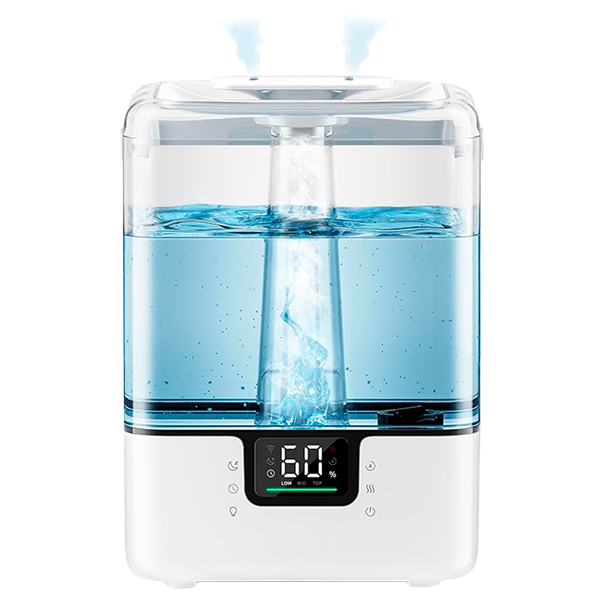Ultrasonic humidifiers are a quiet, efficient way to add moisture to the air, helping create a healthier and more comfortable environment for you, your family, and even your pets. They use a high-frequency transducer or diaphragm to turn water into a fine, cool mist.
These vibrations occur at ultrasonic frequencies which a human ear can’t hear. A built-in fan then disperses this water vapour into the air to increase humidity. In this guide, we’ll explain the key benefits of ultrasonic humidifiers, review popular manufacturers, and help you choose a unit best suited for your space and needs.
For a broader overview of humidifier types, common household scenarios, and leading brands, see our overall guide to getting a humidifier.
Output Rate (ml/hr)
The output rate shows how much mist a humidifier releases each hour, measured in millilitres. The ideal rate depends on your room size and how much humidity you want to achieve.
- <200 ml/hr – Light output: Best for small bedrooms, offices, or personal use near a desk or bed..
- 200–400 ml/hr – Moderate output: Suitable for medium-sized rooms such as living rooms or nurseries.
- >400 ml/hr – High output: Designed for larger spaces, open-plan areas, or very dry climates.
Higher output means quicker relief but usually requires a larger tank and higher energy use.
Tank Size (L)
A larger tank extends run time, meaning less frequent refills, but might make the unit bulkier. If tank size is important to you, you might need to choose a larger humidifier for your space.
- <1L – Compact tanks: Lightweight and portable. Best for placing on desks, in nurseries, or for travel.
- 1–2L – Mid-size: A balance between convenience and capacity, suitable for most bedrooms, small living rooms and kitchens.
- >2L – Large capacity: Allows longer operation without refills. Ideal for living rooms, large areas or overnight use.
Run Time (hours)
Run time shows how long a humidifier can operate continuously before the tank needs refilling. If you want to use it overnight or while you’re away, make sure to choose a model with a longer run time.
- Up to 6 hours – Short-term use: Great for hanging out at home, naps or short office shifts.
- 6–12 hours – Moderate: Works well overnight or during the day without constant refills.
- 12–24 hours – Extended use: Causes minimal interruptions for larger rooms and offers continuous comfort.
- Over 24 hours – Continuous: Premium models designed for hassle-free, long-term humidity control, whether in the office or at home.
Noise Level (dB)
Although ultrasonic humidifiers are generally quiet, they still make some noise – usually comparable to a gentle hum of rain or light shower. The right choice depends on where you’ll be using your humidifier and how sensitive you are to background noise.
- <30 dB – Near silent: Comparable to a whisper. Perfect for nurseries and children’s bedrooms.
- 30–50 dB – Low hum: Similar to a quiet conversation. Fine for most living areas, large bedrooms and kitchens.
- >50 dB – Noticeable: Best for daytime or occasional use, or larger shared spaces such as open-plan living areas, photography studios and workshops.
Mist Intensity Levels
The ability to control mist output gives you more control over your comfort and prevents over-humidifying.
- Single level: Simple on/off operation.
- Two levels: Allows some flexibility to adjust to different room sizes.
- Three+ levels: More precise control, letting you customise intensity, often found in higher-end ultrasonic models.
Mist Type
Some hybrid ultrasonic humidifiers offer a dual mist, allowing them to produce either two independent mist streams or to select between cool and warm mist options. They use ultrasonic technology combined with a built-in heating function.
Warm Mist
The gentle, warm vapour can make a room feel cosier and slightly raise the ambient temperature, which is especially comforting during colder months.
Cool Mist
Cool mist humidifiers produce a slightly colder mist, either through ultrasonic vibrations or an evaporative wick system. Cool mist helps maintain comfortable humidity without increasing room temperature, making these models ideal for year-round use and warmer climates.
Dual Mist
Dual mist humidifiers combine both warm and cool mist functions, allowing users to switch between modes based on the season or personal preference. Warm mist can help reduce germs and provide comfort in winter, while cool mist offers refreshing humidity in summer.
Tank Fill Method
The way your humidifier gets refilled matters. There are two types of fill methods.
- Top Fill – Top-fill humidifiers feature an opening at the top of the tank, allowing users to pour water directly from a jug or tap without disassembling the unit. This design makes refilling and cleaning significantly easier and less messy.
- Bottom Fill – Bottom-fill humidifiers require removing the tank from the base and inverting it to fill from the bottom. While often more secure against spills during operation, this design can be less convenient when refilling or cleaning, as it typically involves more handling and careful positioning.
UV/Antimicrobial Treatment
Many modern humidifiers use UV light or antimicrobial coatings to prevent bacteria, mold, and other microorganisms from growing in the water tank. UV-C lamps kill germs before mist is released, while antimicrobial materials reduce buildup, keeping the mist cleaner and maintenance minimal.
Key Features to Consider
Modern humidifiers come with a range of additional features to choose from, making them even more convenient for different life scenarios. Some of the common ones include:
Display Type
Humidifiers typically come with either an analogue, digital, or touch display and controls, each affecting how runtime and humidity are displayed.
- Analogue – usually have mechanical dials and timers from 1–12 hours, but lack precise control.
- Digital – feature LED or LCDs showing humidity and timers, commonly ranging from 1–12 hours, sometimes with minute-level adjustments and continuous mode.
- Touch-control – offer sleek LED or LCD readouts, similar timer ranges (sometimes up to 24 hours), and precise settings with preset modes.
Overall, digital and touch displays provide greater accuracy and convenience compared to analogue models, but analogues tend to be cheaper.
Mineral/Water Filter
Ultrasonic humidifiers often use mineral or water filters to reduce dissolved minerals and impurities released into the air. Hard tap water can create fine white dust, so a mineral filter helps trap calcium, magnesium, and other particles before they reach the ultrasonic plate. This prevents white dust buildup and protects the unit’s internal components. Using distilled water works too, but built-in filters are way more convenient.
Most filters require replacement every few months, depending on water hardness and use.
Smart/App Connectivity
Many modern humidifiers now offer Wi-Fi connectivity, allowing you to control them remotely through a smartphone app. Some models even support voice commands via Alexa or other smart assistants for convenient, hands-free operation.
Most common app functions include:
Design & Usability
Ultrasonic humidifiers come in a range of shapes, sizes, and finishes to suit any home. Most feature plastic bodies with clear tanks, though some use glass or metal. From minimalist designs to modern pastels, there’s a style for every space.
- Shapes: The most common are towers, cubes, or cylinders.
- Tank fill method: Top-fill designs are easier to clean and refill than bottom-fill designs.
- Materials: BPA-free plastics are recommended for safety concerns, especially for households with children. Metal and glass tend to last longer, but are also heavier.
- Portability: Look for ergonomic handles, lightweight designs, and spill-resistant tanks if you’re planning to move the unit between rooms.
Energy Use (W)
Humidifiers are generally energy-efficient, but usage varies. If you’re concerned about electricity bills or you’re planning to run the humidifier nonstop, look for low-wattage models or those branded ‘Eco’.
- <20W – Low consumption: Common for small ultrasonic models.
- 20–40W – Standard: A good balance of performance and efficiency.
- >40W – High output: Common in large-capacity or evaporative models.
Certifications
Check for independent certifications to ensure your humidifier meets safety, performance, and environmental standards, and look for awards from reputable publications and journals.
- CE / UKCA: Complies with EU/UK safety standards.
- ETL / UL: North American safety certification.
- RoHS: Confirms reduced hazardous materials.
- BPA-free: Safe materials, especially important for children’s rooms.
Leading Manufacturers Overview
Vicks
Best for: Warm & Cool Mist Options | Reliable Performance | Great Value
A trusted household name with decades of experience in air care and health products. Their ultrasonic humidifiers are designed for everyday comfort and respiratory relief, with many models offering dual mist options.
- Compatible with soothing VapoPads for added comfort
- Easy-to-clean tanks and accessible replacement parts
Cons: Some models can be slightly louder at higher mist settings; designs focus on practicality over aesthetics.
Dyson
Best for: Premium Performance | Air Purification + Humidification | High-End Design
Dyson takes humidification to a luxury level by combining multiple air treatment technologies in one unit. Their ultrasonic humidifiers often include built-in HEPA filtration, UV-C purification, and even cooling fan functions. With app connectivity and auto-adjust sensors, Dyson’s machines maintain optimal humidity levels with minimal effort.
- Hygienic mist output using UV-C sterilisation technology
- Integrated air purification and fan functions
- Sleek, minimalist design with intelligent climate control
Cons: Significantly higher price than standard humidifiers; replacement filters and parts can be costly.
Pure Enrichment
Best for: Budget-Friendly Comfort | Compact Rooms | Everyday Use
Affordable yet dependable ultrasonic humidifiers designed for small to medium spaces. Their minimalist designs focus on ease of use and quiet operation. Ideal for first-time buyers or those who just need simple, reliable moisture without complex features.
- Whisper-quiet operation suitable for sleep environments
- Auto shut-off and optional night light modes
- Lightweight, compact build for easy placement
Cons: Smaller tanks require frequent refilling; they lack smart connectivity or advanced features.


